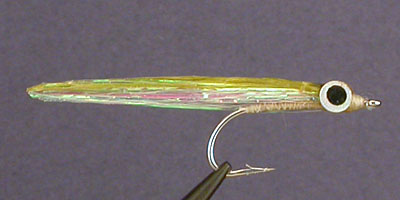Fly Tied By:
Jack
Hanley
Recipe
By: Jack Hanley
Story By: Jack "Have Rod Will
Travel" Hanley
Home: Barnstead, New
Hampshire
E-mail: jhanley1@chi.tds.net |
Jack enjoys fly-fishing anywhere there
is water, both salt and fresh. He gets out fishing about
120 days a year, and when traveling on business he packs his
fly-rod (or two). Jack's work has enabled him to fish in more
than 30 states and several countries.
|
 The
Flash Minnow is one of three flies I will not leave home
without. The other two are the Mohlon/Marabou Leech and the Clouser Deep Minnow. For me these three
flies have been constant producers, catching everything from Tarpon
to Tiddlers. They have accounted for more than 50 species I have
caught "on the fly". The
Flash Minnow is one of three flies I will not leave home
without. The other two are the Mohlon/Marabou Leech and the Clouser Deep Minnow. For me these three
flies have been constant producers, catching everything from Tarpon
to Tiddlers. They have accounted for more than 50 species I have
caught "on the fly".
Streamers are my favorite big
fish fly. I learned from my fly-fishing mentor, Grandpa Foley, who
loved his Mickey Finn and always said that "any fish worth fighting
will eat a minnow". Lee Wulff's articles on tying without thread and
his fascination with glues were likely responsible for starting me
experimenting with hot glue guns, epoxies, and eventually
Softex. And I have been fascinated with shaping streamer wings
ever since Nick Lambrou, one of New England's best fly designers and
fishermen, showed me how to shape the back of a streamer with a
little head-cement between my finger and thumb.
The J.B.L.
Flash Minnow (top in picture)--
With fishing buddies Bill
Koladish (one of the sport's most innovative Largemouth and Striper
fly creators) and Larry Alting, many hours were spent playing with
the sink rates of Flash Minnow prototypes in the kitchen sink and in
water glasses, as well as extensive field testing on the water.
Together we have fished some pretty ridiculous experiments over the
years, some so ugly that I slip downstream for fear of being laughed
off the water. But in the J.B.L. Flash Minnow (named, of course,
after Jack, Bill, and Larry) I think we found a real winner. At
least it works for me! I think it will work for you,
too.
JL91 (bottom in picture)--
Larry and I had been chasing
Stripers all night and just before daybreak the tide changed and we
saw the water boiling with sand eels (lances). They were clearing
the water as if Snapper Blues were tearing them apart from
underneath. We fished in the pod for more than an hour, never
hooking up. We left scratching our heads.
The next night we made our way
back to the same spot. Again, the water boiled. But this time, in
the light we could make out a brownish 14" fish busting the
skittering sand eels.
"Pollack", I asked?
"What's the smallest streamer you
have with you?"
"A Mickey Finn in the back of the
Shad box. Try it."
Well, Larry threw it about a
hundred times with no luck, finally skating it with a double-handed
strip until the only stupid fish in the bunch tried to commit
suicide. It's a brown trout!
I told Larry to bring a 4Wt and
some 5X tippet the next day, and I would bring the answer. I spent
the afternoon at the fly bench refining my latest experiment,
matching the hatch not only in size and color but in sink rate and
action. When dawn broke, I was able to hand Larry one of the
prototypes. I had made six different sink rate versions of the same
fly. Larry started with the floater, and over the next hour all hell
broke loose. There wasn't 20 seconds when both of us weren't hooked
up. As the frenzy started to subside Larry looked over and said "I
just landed and released my 50th fish!" I had caught only
41, but had continued to experiment through the frenzy. As we walked
back to the car Larry asked me the name of the fly. I responded: "I
didn't have one until today…. Perhaps we'll call it Jack and Larry's
91!"
--Jack Hanley
|
Flash Minnows as
designed and tied by Jack Hanley |
|


Photos by Peter Frailey
|
Tying Order:
Hook:
Because bass and stripers
are "head-hunters", I prefer a short-shank hook with a wide
gap. For trout and salmon, try a 2X to 4X long hook. Or, for
the best weedless fly you'll ever use, try a keel hook. It
slides right over lily pads!
Weight: None, or
various amounts to achieve desired sink rates. For middle
depths, try some lead on the hook shank. For deeper depths,
try a cone head under the epoxy eyes.
Thread: White.
Body: Polarflash topped with darker
bucktail, both to match the hatch.
Eyes:
Over-sized Holograph. I believe big fish key in on
the terrified big-eye look.
Head Cement: Epoxy
which also holds the eyes.
Body
Shaping: I use Softex. Using your finger and
thumb, shape the rear third of the body into a baitfish shape.
This shaping also eliminates the materials from fouling around the
hook bend. Shape the entire body if you are seeking a
spoon-fly look.
Comments:
Cover the water
thoroughly by using different sink rates. A relatively
fast strip seems to work best. |
|
|



